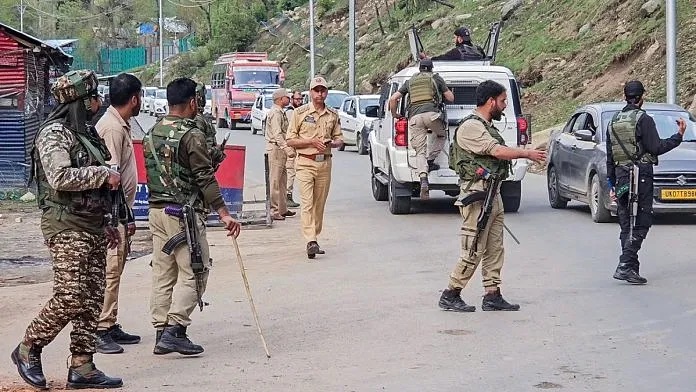By Mirza Abdul Aleem Baig
The recent terrorist attack in Pahalgam, Jammu & Kashmir, which claimed at least 28 lives and injured dozens more, has once again thrown South Asia into a spiral of tension and uncertainty. The attack had generated outrage and grief and shocked the region and reignited the bitter cycle of blame and retaliation between India and Pakistan.

Beyond the immediate horror of the violence, a troubling aftermath has unfolded; a storm of sensationalist media coverage, a surge in disinformation on social media, and a cascade of high-stakes diplomatic and military reactions that risk further destabilizing South Asia.
India’s reaction was both rapid and resolute. In an emergency meeting of the Cabinet Committee on Security chaired by Prime Minister Narendra Modi, New Delhi rolled out a series of punitive measures directed at Islamabad. These included diplomatic downgrades – halving the size of embassies, expelling Pakistani military attachés – and the closure of the Attari-Wagah border crossing.
The SAARC Visa Exemption Scheme for Pakistani nationals was suspended, and India’s Foreign Secretary cited “cross-border linkages” as justification for what was described as a “zero-tolerance” approach moving forward. Most symbolically – and perhaps most consequential decision, however, was the indefinite suspension of the Indus Waters Treaty (IWT) – a World Bank-mediated agreement signed in 1960 that had survived wars and political ruptures for over six decades.
The treaty had established a framework for the shared use of the Indus river system, with India receiving control over the eastern rivers (Ravi, Beas, Sutlej) and Pakistan over the western rivers (Indus, Jhelum, Chenab). India’s announcement to halt flows from these rivers is not just a strategic move, new lever of geopolitical pressure, it is a seismic shift that risks triggering a humanitarian and ecological crisis in Pakistan, where tens of millions rely on these waters for agriculture, drinking, and industry – especially at a time when the country faces water scarcity exacerbated by climate change, mismanagement, and population growth.
Beyond its immediate implications, India’s suspension of the IWT is emblematic of a broader unraveling of regional cooperation. South Asia’s already fragile regionalism – once championed through platforms like SAARC – has steadily deteriorated, largely due to New Delhi’s growing preference for bilateral dominance over multilateral engagement.
The weakening of SAARC as a regional forum has closed important avenues for dialogue, conflict resolution, and economic collaboration. By halting the last functional and durable bilateral mechanism between India and Pakistan, New Delhi has chosen disruption over diplomacy, compounding mistrust rather than addressing the deeper causes of insecurity.
This action also places the World Bank, as the treaty’s official guarantor, in a position of responsibility. It cannot afford to remain passive in the face of such a dramatic breach of trust. The World Bank must seek urgent clarification from the Indian government, reaffirm the binding nature of the treaty, and push for the restoration of diplomatic processes.
Indistinguishably, multilateral bodies such as the United Nations, the International Court of Justice, and other international forums must recognize this for what it is: a violation of established international norms, and a precedent that threatens the legal and institutional integrity of global treaties.
While the geopolitical stakes are undeniably high, the media’s role in shaping the narrative around the Pahalgam attack cannot be ignored. Rather than promoting caution and critical inquiry, much of India’s mainstream media resorted to a combative, accusatory tone.
Television studios quickly became arenas for blame and escalation. Guests and anchors, often with little regard for facts, called for punitive action and amplified nationalist sentiment. This rush to judgment, long before investigations had concluded, has only served to polarize public opinion and harden positions.
Adding fuel to the fire, social media platforms like Facebook, Twitter/X, and YouTube became echo chambers for outrage and misinformation. Misleading videos, photoshopped images, and hashtags calling for war against Pakistan flooded timelines. Many of these posts originated from anonymous or suspicious accounts, suggesting coordinated disinformation campaigns. Such content often trends faster and spreads wider than verified reports, thanks to algorithms designed to reward engagement, not truth.
Social media companies can no longer shirk their responsibility. These platforms are not just neutral conduits for information – they are now deeply entangled in the political and security dynamics of the regions they serve. They must strengthen moderation systems, particularly in local languages such as Urdu, Hindi, and Kashmiri. This means hiring more regional content reviewers, partnering with local fact-checking organizations, and ensuring that flagged content is reviewed within hours, not days.
There is also an urgent need for global tech firms to collaborate with governments, without compromising civil liberties, and with independent watchdogs to identify and dismantle coordinated disinformation networks. It is no longer acceptable for these companies to turn a blind eye to the weaponization of their platforms in times of crisis. Their actions, or inaction, now have real-world consequences that can escalate regional tensions and endanger millions.
Prime Minister Modi’s ambition to elevate India as a global power, one capable of shaping international norms, influencing the world economy, and asserting strategic authority – cannot rest solely on military modernization or diplomatic posturing.
For India to earn its place as a responsible leader in the emerging multipolar world order, it must also be seen as a stabilizing force in its own neighborhood. Regional peace is not a peripheral concern, it is a central pillar of global credibility. History shows that no nation can rise to true global prominence while embroiled in endless regional conflict or while acting outside the norms of international law.
Yet, in moments like this, India appears to be sacrificing long-term strategic stability for short-term political gain. Undermining the Indus Waters Treaty, one of the last remaining trust-building instruments between India and Pakistan, not only damages India’s reputation as a treaty-abiding democracy but also signals to the world that India may choose coercion over cooperation when faced with adversity.
That message is incompatible with Modi’s larger vision of India as a “Vishwaguru” – a global teacher and civilizational leader. The world’s great powers are not only militarily strong; they are trusted stewards of order. By fueling media hostility at home and tolerating digital disinformation wars that stoke cross-border hatred, India risks eroding its diplomatic capital on the global stage.
In addition, allowing jingoistic rhetoric to replace dialogue does not serve India’s economic aspirations. Investors and allies alike watch regional developments closely, and instability –especially with a nuclear-armed neighbor – raises red flags for trade, investment, and long-term strategic partnerships. A foreign policy built on reactive aggression and broken agreements undermines the very goals of global respect and leadership that the Modi government seeks.
Conversely, Pakistan also faces a critical choice. If it continues to operate from a purely defensive and reactionary posture, responding to Indian moves without shaping a proactive narrative, it will remain trapped in a cycle of geopolitical marginalization.
Pakistan must do more than deny involvement in such attacks; it must articulate a clear and constructive vision for regional peace. This includes deepening internal reforms, countering extremist ideologies, and enhancing transparency on security issues that directly impact bilateral trust. Only then can it meaningfully challenge the narrative that often paints it as a perpetual source of instability.
Both nations must recognize that strength lies not in retaliation, but in resilience and restraint. South Asia has long been hostage to a politics of provocation, where public sentiment is manipulated and peace is postponed indefinitely. A new regional leadership model is possible, one where moral authority stems not from domination, but from dialogue; not from disruption, but from diplomacy.
The tragedy in Pahalgam could have united the region in shared mourning and mutual resolve. Instead, it has become another flashpoint in a conflict that refuses to die. For South Asia to escape this cycle of crisis and escalation, a cultural and institutional shift must occur.
Media must return to the principles of truth and balance. Social media platforms must take responsibility for the real-world impact of their virtual ecosystems. And leaders must resist the temptation to weaponize tragedy for political gain. Until then, peace will remain the most elusive casualty of conflict – not just in Kashmir, but across the entire region.
Author: Mirza Abdul Aleem Baig – President of Strategic Science Advisory Council (SSAC) – Pakistan. He is an independent observer of global dynamics, with a deep interest in the intricate working of techno-geopolitics, exploring how science & technology, international relations, foreign policy and strategic alliances shape the emerging world order.
(The opinions expressed in this article are solely those of the author and do not necessarily reflect the views of World Geostrategic Insights).
Image Credit: ANI







